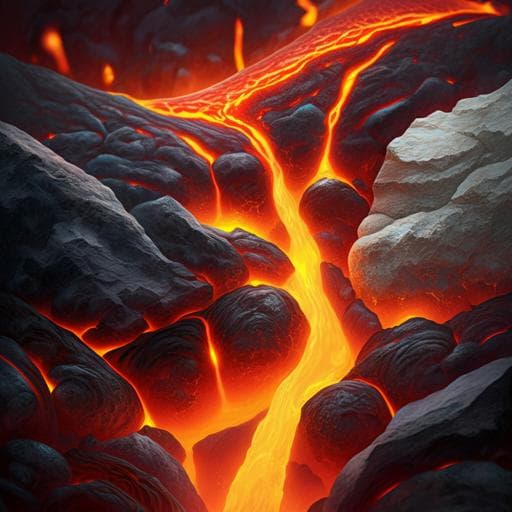
Earth Sciences
An andesitic source for Jack Hills zircon supports onset of plate tectonics in the Hadean
S. Turner, S. Wilde, et al.
This compelling study by Simon Turner and colleagues challenges traditional views on Earth's early crust by revealing that the ancient Jack Hills zircons originated from andesitic melts in a subduction environment, raising intriguing questions about the onset of plate tectonics as early as 4.3 billion years ago.
~3 min • Beginner • English
Introduction
The study addresses the long-standing question of the composition and tectonic setting of Earth’s earliest crust, which is difficult to resolve due to the scarcity of rocks of appropriate age. Detrital zircons from the Jack Hills (Western Australia), dated between 4.4 and 3.3 Ga, are known to derive from igneous sources and have been central to debates regarding early crustal composition and geodynamics. Prior interpretations based largely on Hf isotopes and limited trace element fingerprints span hydrous granites (implying Earth-like conditions), more mafic intraplate sources, and even impact melts—some of which do not require plate tectonics. Predictions of episodic or stop–start Archean plate tectonics would imply temporal alternation between within-plate and subduction-like geochemical signatures. To provide a complementary constraint independent of Hf isotopes, this work exploits a broad suite of zircon trace elements and zircon/melt partitioning to reconstruct parental melt compositions, aiming to clarify the tectonic affinity of the zircon protoliths and assess potential secular changes from the Hadean to Mesoarchean.
Literature Review
Previous studies on Jack Hills zircons have inferred aspects of the protolith composition from Hf isotopes and identified igneous origins, with zircon crystallization temperatures near ~700 ± 50 °C. Competing hypotheses include derivation from hydrous granites, intraplate mafic sources, or impact melts. Some models propose intermittent early plate tectonics, which should manifest as temporal shifts between within-plate and subduction-like trace element signatures. Zircon trace element fingerprinting has suggested continental igneous sources rather than mafic intraplate affinities. However, many prior datasets focused on REEs alone, and empirical/experimental zircon-melt partition coefficients vary, particularly for elements like Nb that are highly incompatible in zircon. The present study builds on experimental partitioning consistent with lattice strain models and integrates broader trace element ratios (e.g., Th/Nb, Th/Yb vs Nb/Yb, Dy/Yb, Sr/Y) to assess tectonic setting, while also comparing results with TTGs and impact-related compositions (e.g., Sudbury).
Methodology
- Sample selection and U–Pb geochronology: Zircon grains were extracted from a Jack Hills metasediment (W74 site). Two epoxy mounts (~50 zircons each) were prepared with CZ3 zircon standard (206Pb/238U age 564 Ma). After optical and CL imaging to screen for inclusions/cracks, 37 grains on mount 1 and 24 on mount 2 were analyzed. SHRIMP II (Curtin University) single-cycle runs established approximate ages followed by 6-cycle runs for precise U–Pb. Mass resolution ~5000; U/Pb normalized to CZ3 (206Pb/238U=0.0914). 1σ uncertainties for U/Pb of standard: 1.52% (mount 1), 1.32% (mount 2). Common Pb correction used Broken Hill composition. Data processed with Squid and Isoplot; discordant (>5%) and altered grains were excluded.
- Trace element analyses: LA-ICP-MS (Agilent 7700x with Photon Machines 193 nm excimer laser, HelEx cell) at Macquarie GeoAnalytical. Conditions: 50 μm spot, 7.59 J/cm2, 5 Hz, 60 s background + 120 s ablation. NIST-610 used for external calibration, Zr for internal. BCR-2G, GJ and 91500 monitored accuracy/reproducibility. Data reduction with GLITTER; spectra trimmed to avoid contamination and zoning. P and REE patterns used to screen for alteration. External reproducibility and partition coefficient uncertainties were propagated into melt composition ratio errors.
- Inversion to melt compositions: Used zircon/melt partition coefficients from an experimental study on an andesitic composition (Burnham & Berry, 2012) covering LILE, HFSE, and REEs and consistent with lattice strain theory. Ratios of partition coefficients were emphasized to minimize temperature dependence. Sensitivity tests used empirical high-silica rhyolite glass partitioning (Padilla & Gualda, 2016) to evaluate Nb behavior.
- Protolith SiO2 estimation: Established a global Th/Y–SiO2 regression using 41,186 whole-rock analyses (50–70 wt.% SiO2) from GEOROC (>100,000 initial, unfiltered for age). Linear regression: Th/Y = 0.0269 × SiO2 − 1.3169 (R2 = 0.9812); binned at 1 wt.% SiO2 with calculated standard errors. Maximum/minimum regressions define ±1.1 wt.% statistical uncertainty at high SiO2, combined with analytical and partitioning uncertainties to a total ±3.5 wt.% on inferred melt SiO2. An Archean-only regression (Th/Y = 0.1 × SiO2 − 6) would yield higher SiO2 but was not adopted due to TTG dominance and the study’s conservative approach.
- Comparative tectonic discrimination: Plotted inferred melt compositions on Th/Yb vs Nb/Yb and Th/Nb vs Dy/Yb diagrams against fields for MORB, OIB, modern arcs, TTGs, and Sudbury impact-related rocks to assess tectonic affinity and garnet influence (via heavy REE and Sr/Y behavior).
Key Findings
- The melts in equilibrium with 4.3–3.3 Ga Jack Hills zircons have average SiO2 of 59 ± 6 wt.% and trace element ratios Th/Nb = 2.7 ± 1.9, Dy/Yb = 0.9 ± 0.2, and Sr/Y = 1.6 ± 0.7.
- These signatures are inconsistent with intraplate mafic sources, TTG suites, or Sudbury-like impact melts, and instead align with modern subduction-related andesites (elevated SiO2 and Th/Nb, low Dy/Yb, low Sr/Y, flat heavy REE patterns indicating absence of significant garnet control).
- Tectonic discrimination (Th/Yb–Nb/Yb; Th/Nb–Dy/Yb) places the inferred melts well above MORB/OIB fields and within/above modern arc fields; even when using alternative empirical partition coefficients, melts remain displaced from oceanic basalt fields.
- No statistically meaningful secular change is observed in inferred melt SiO2, Th/Nb, or zircon crystallization temperatures from 4.3 to 3.3 Ga, indicating stable compositional and tectonic affinity from the Hadean to Mesoarchean.
- The average inferred protolith composition resembles low-Ti enriched basaltic andesites of the Nuvvuagittuq Greenstone Belt (potentially 3.8–4.3 Ga), consistent with subduction initiation sequences and providing a plausible source for later TTGs via partial melting with residual garnet.
Discussion
Reconstructed melt compositions from Jack Hills zircon trace elements exhibit andesitic SiO2 and elevated Th/Nb ratios characteristic of modern subduction zone magmatism, while low Dy/Yb and Sr/Y argue against significant garnet involvement typical of TTGs. These geochemical traits place the protoliths within arc fields and distinctly separate them from MORB/OIB and impact-related compositions. Sensitivity tests using empirical partition coefficients shift Nb/Yb but do not alter the core inference of elevated Th/Nb and arc-like affinity. The absence of secular variation across 4.3–3.3 Ga counters expectations of alternating within-plate and subduction-like signatures from episodic early tectonics, instead implying persistent subduction-like processes. While a subduction signature does not by itself prove fully modern plate tectonics, the results are fully consistent with an early onset of modern-style plate interactions and align with recent geodynamic models and Si and Mo isotope evidence. The compositional similarity to Nuvvuagittuq enriched basaltic andesites supports scenarios where early arc-like sequences could generate TTGs through partial melting in the presence of residual garnet.
Conclusion
By inverting zircon trace element data with robust zircon/melt partitioning, the study reconstructs parental melts for Jack Hills zircons as broadly andesitic with arc-like signatures. These results exclude intraplate mafic, TTG, and impact melt sources and indicate no secular compositional change from 4.3 to 3.3 Ga. The presence of a subduction-like geochemical signature in Hadean–Mesoarchean protoliths supports the permissibility of an early onset of modern-style plate tectonics. Potential future research directions include: expanding datasets of co-located U–Pb ages and comprehensive trace elements for Hadean–Archean zircons; refining zircon/melt partition coefficients across compositions and temperatures, especially for HFSE like Nb; integrating multi-isotope (e.g., Hf, Si, Mo) constraints with trace element inversions; and targeted studies linking ancient arc-like sequences to TTG genesis via experimental and field-based investigations.
Limitations
- Inferences rely on zircon/melt partition coefficients; element-specific uncertainties (notably Nb, highly incompatible in zircon) can shift positions on discrimination diagrams. Results were tested with both experimental and empirical coefficients to assess robustness.
- Zircon analyses may be affected by micro-inclusions and host heterogeneity; extensive screening and trimming were applied, but residual effects cannot be entirely excluded.
- The SiO2 estimation uses a global Th/Y–SiO2 regression unfiltered for age; although conservative and well constrained (R2 ~0.98), an Archean-only regression yields higher SiO2 due to TTG dominance.
- Trace element inversion assumes equilibrium and representative sampling of parental melts; metamorphic or alteration effects were mitigated but may not be fully eliminated.
- Lack of direct whole-rock protoliths necessitates inference from detrital zircon chemistry, which provides indirect constraints on source melts.
Related Publications
Explore these studies to deepen your understanding of the subject.







